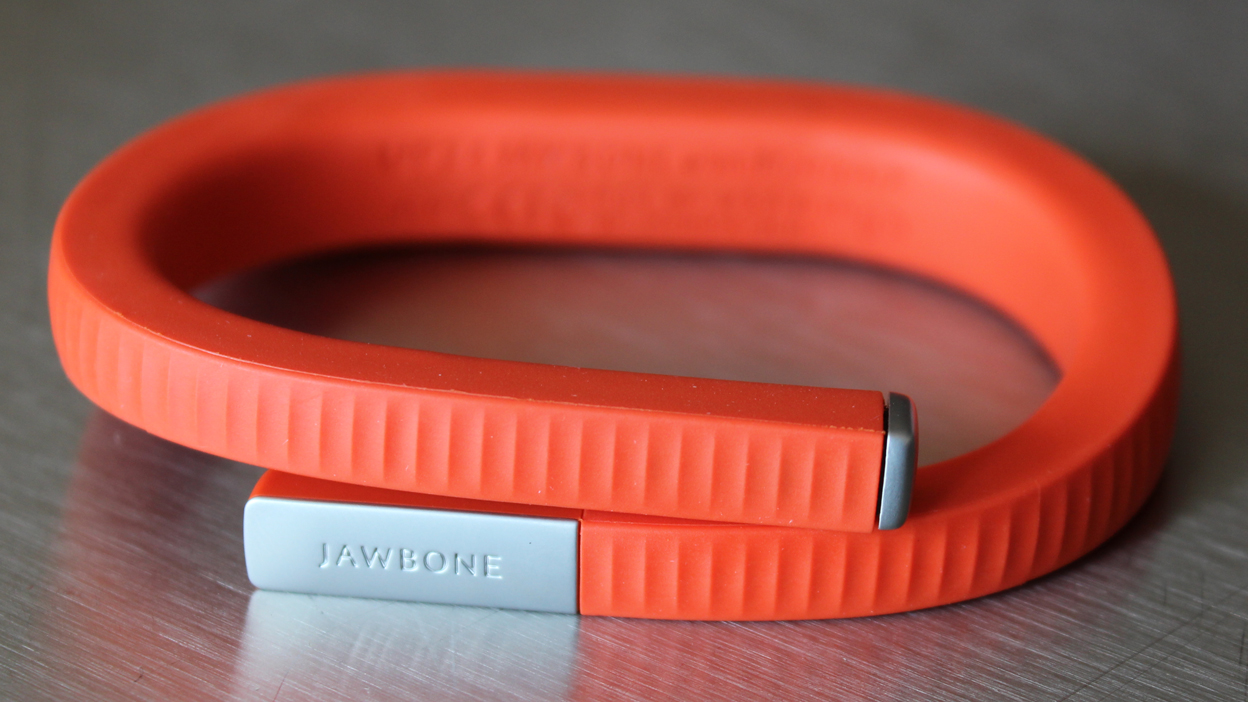TechRadar Verdict
The Jawbone Up24 is one of the most inspiring fitness wearables that you can latch onto your wrist.
Pros
- +
Wireless syncing added
- +
Stylish and lightweight
- +
Very soft rubber for comfort
- +
iOS and Android compatible
Cons
- -
No display for on-demand stats
- -
Doesn't have a web app
- -
Works with just 10 Android phones
- -
2.5mm stereo jack for charging
Why you can trust TechRadar
Update: The Up24 may have been superseded by the Jawbone UP2 and Jawbone UP3, but you can still pick it up fairly cheaply around the traps. We've updated the review to reflect this.
Original review below:
The smart and sporty Jawbone Up24 is the most fashionable, lightweight and comfortable fitness tracking wearable you can buy, and it has a beautiful app to match. Its activity and sleep tracking internals are also just about as brainy as the Fitbit Force and Nike FuelBand SE.
Some functionality is sacrificed in the name of vanity. There's no display on the device itself for on-demand workout stats or a web-based portal to chart the quantified self data it silently collects. All metrics have to be synced to an iOS or, as of this month, an Android app.
The good news is that Jawbone Up24 is able to wirelessly sync these accurate step and sleep quality numbers through Bluetooth. This is a major improvement over the original Jawbone Up transfer method that required physically plugging in the device for each and every upload.
Now, as the Jawbone Up24 name suggests, this new version can truly be worn 24 hours a day without the need to take it off between syncs. Combined with the 3.0 version of its colourful app and newly released Android support, this is one of the top wellness motivators, unless of course you own a Windows Phone 8 or other non-compatible device.

Design
The flexible Jawbone Up24 bracelet is coated with the same incredibly smooth non-latex rubber as its nearly identically designed predecessor. The company goes out of its way to say that this silky material is medical-grade and hypoallergenic, meaning it won't give you a nasty rash like the recently recalled Fitbit Force.
Beneath this rubber layer, the bracelet has a spring-steel inner-core that gives it that deformation-resistant elasticity. Its solid design ends up being less malleable than the Fitbit Force wristband, but it's even softer to the touch on the outside, an important feature for any wearable meant to be worn 24/7. Eye-catching OLED displays, the full gamut of metrics and colourful apps might turn heads, but any wrist-worn gadget has to be comfortable for these extras to be worth it.
Jawbone Up24 weighs in at just 20 grams. That means it's easier to forget that you're wearing it, compared to the Fitbit Force and the hard rubbered Nike FuelBand SE, both of which are 30 grams. It's also more fashionable than its two fitness-focused rivals.
The textured bracelet is thinner than its more plain-looking competitors, measuring about a centimetre in the direction of forearm to hand. Compare that to the 19mm width of the Fitbit Force. It's not a massive difference, but wholly beneficial when slipping on cuffed shirts or jackets. Constantly removing and attaching it won't need to be part of your fitness routine.
The bracelet thickness actually narrows as it wraps around the wrist to two overlapping ends. These unique prongs provide 38mm of security and stand out from the normal wristwatch clasp used in the Fitbit Force and other trackers. It's also easier to put on and take off.
Jawbone Up24 comes in two colours: Persimmon (reddish orange) and Onyx (black). Personally, I miss the light blue and mint green of the original Up bracelet, but orange and black are a good start. There are also three sizes again: small, medium and large to fit a variety of wrists.
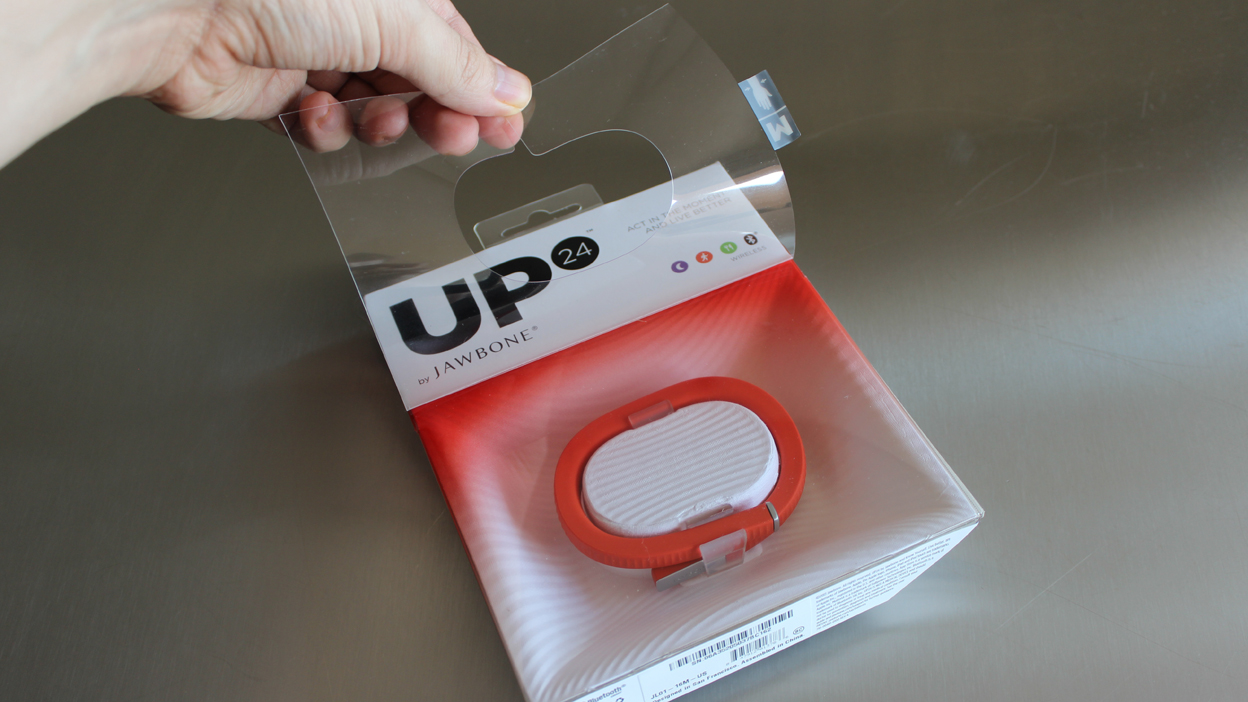
At the store, you won't need to break out the measuring tape, as the packing includes a clever plastic layer with a size-appropriate hole through the centre. It can be lifted to see if your wrist fits. Jawbone offers a traditional print-out guide just in case you're ordering online.
What's missed more than additional colours is a display, especially after having used the flashy dot matrix LED of the Nike FuelBand SE and conventional OLED display of the Fitbit Force. You'll have to break your habit of reaching for your wearable to check on progress, as you'll now need an app for that.
The only two backlit icons underneath the non-latex rubber are a sun and a moon. They indicate activity and sleep mode. Everything else will have you back to the app.
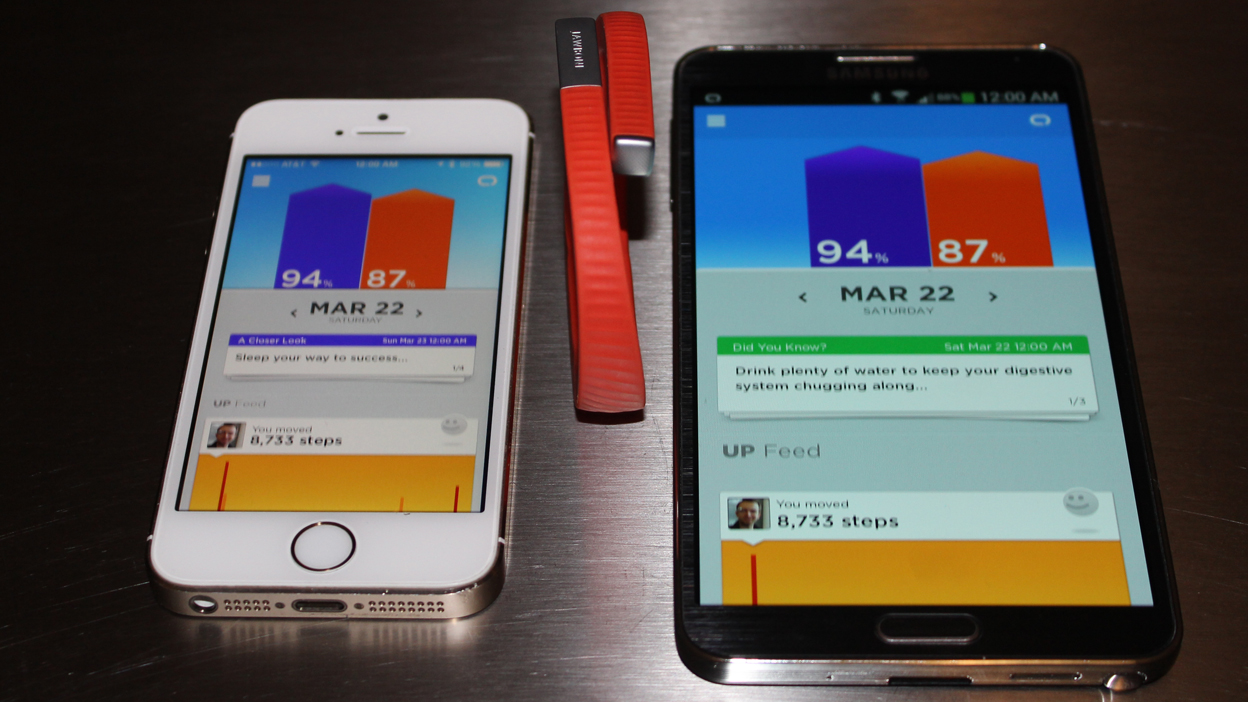
App
Jawbone Up24 is lightweight, but its multilayered app is not. It's full of rich colour, helpful wellness tips plus detailed activity and sleep analysis.
Activity is represented by a vertical orange bar that shoots up with more physical movement. Tapping it reveals a horizontal 24-hour timeline that spikes vertically with hourly movement. It's based on the number of steps taken and miles or kilometres traveled.
Additional tabulations below the bar graph include active time, longest active time, longest idle time, total calories burned, active calories burned and resting calories burned. It's almost the full spectrum of fitness metrics. Flights of stairs climbed is the one missing stat I've seen before elsewhere. Unlike the Fitbit Force, there's no altimeter sensor packed into this tiny bracelet.
That's okay because the Jawbone Up24 sensors for everything else are more accurate and customisable than its wearable peers. Fitbit Force, for example, likes to add five phantom steps for every 100 taken, skewing the numbers quite a bit by the end of the day. The Up24 didn't do that, and it includes a "Calibrate Your Band" option deep within its settings menu to improve accuracy.
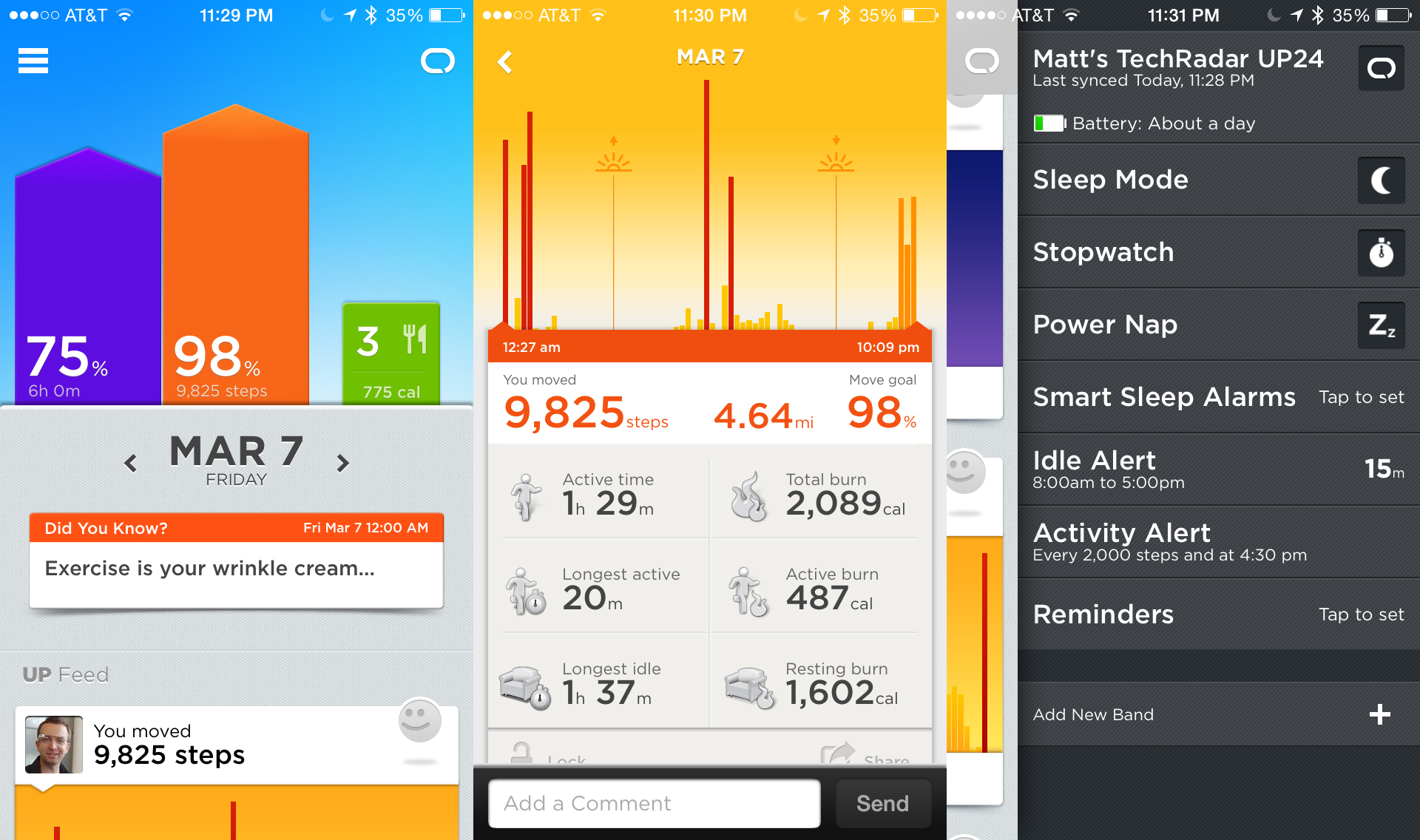
The app's invitingly bright colour and the overall better accuracy are a good motivator, but nothing gets you on your feet faster than a slap on the wrist. Its idle alerts are more like a joybuzzer than electroshock therapy, causing the bracelet to vibrate whenever you're inactive for a set amount of time. It can be set to gently buzz your wrist every two hours all the way down to every fifteen minutes.
Idle alert reminders also include a start time and end time, so it should only buzz you during work hours, for example, and not when you're at home watching a movie. Nike included this feature in its FuelBand SE bracelet, but its hourly "move reminders" don't have the same idle time customisations. Garmin Vivofit may be the only one to do it better with a red inactivity bar that visually grows throughout the set sedentary time period before the nagging begins.
The motivators don't stop there. "Today I Will" challenges encourage you to get to sleep a few minutes earlier than the night before, drink all eight recommended glasses of water in 24 hours or walk a few additional steps by the end of the day. These personalised challenges are based on how well you've met your goals in the past week and make the whole Up system feel as if it's getting to know you better than any other tracker.
Workout, pill-taking and custom tasks can be programmed in via the reminders menu that sends a notifications to both the phone and the bracelet. Finding teammates through your contact list, Facebook and Twitter can also fire you up. There's room for comments, but this peer-to-peer motivation is more likely going to come from you seeing how much everyone else is obliterating your steps count in the well-laid out Up newsfeed.
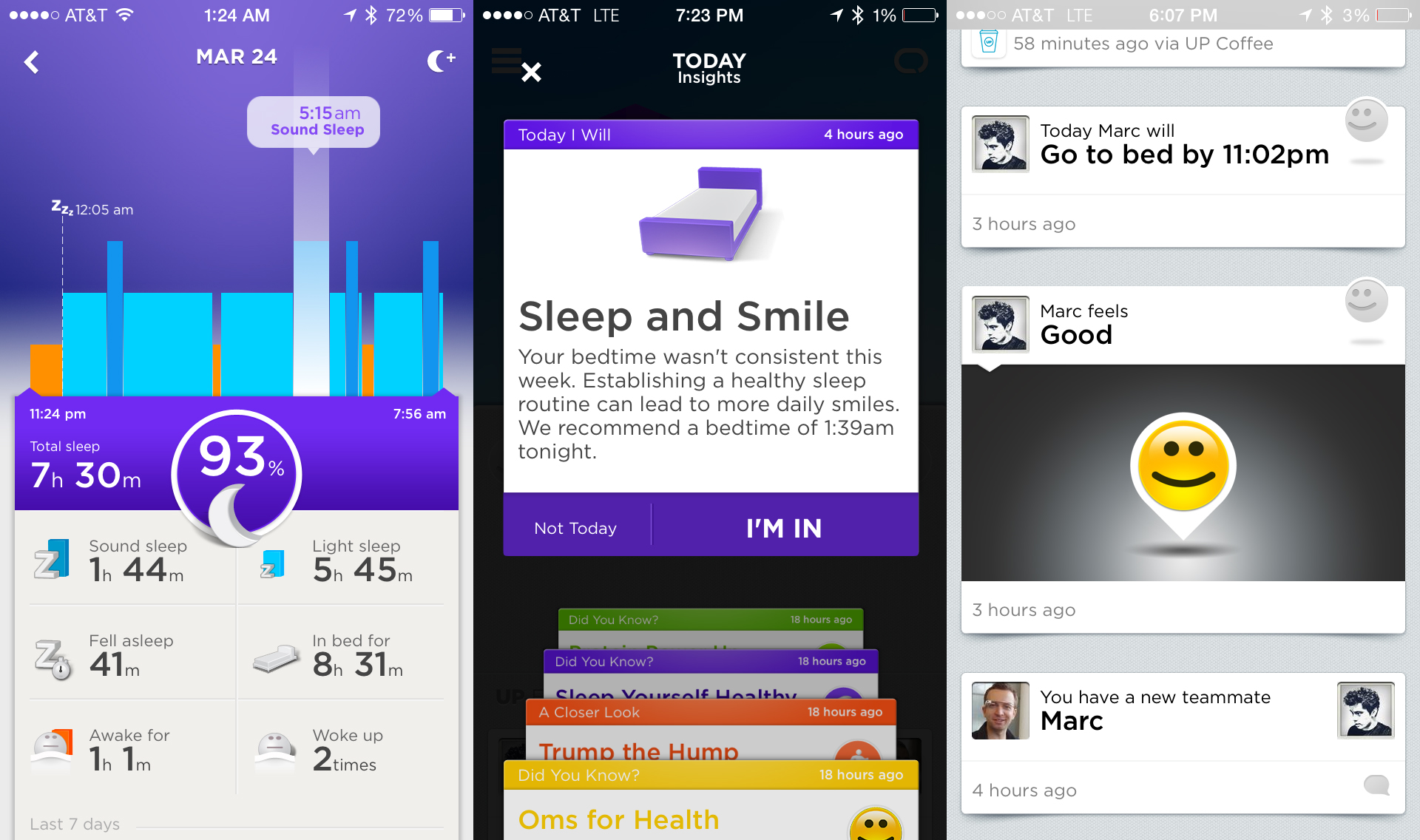
Sleep tracking
Most gadgets keep us awake past our bedtime, but the Jawbone Up24 could actually help us catch more Zs. Its sleep tracking capabilities chart the traditional eight hours with dark blue, light blue and orange vertical bars on a timeline. This corresponds to you being sound asleep, restless and awake in bed.
The app's sleep mode is surprisingly accurate for a fitness bracelet, going as far as reporting when it thinks you fell asleep and total awake time. Kicking the Jawbone Up24 into sleep mode requires pressing the device's single button at the end of one of its overlapping prongs.
Sleeping on the job of switching it over to this mode isn't a problem. You can still log unconscious hours manually, and the Up24 will even guess as to when you were asleep. It works far better than the FitBit Force's sleep tracking, which is equivalent to a lot of tossing and turning.
Fitbit's sleep tracking performance has always been suspect and while Nike added a sleep mode to its FuelBand SE, it doesn't actually keep tabs on sleep quality, just time slept. That leaves few challengers for the Jawbone Up24, although I did take a look at the Withings Aura at CES 2014. It's dedicated to sleep tracking and costs twice as much, but could roll Jawbone off its king-size mattress throne when it comes out.
Your partner in sleep will appreciate this: the Jawbone Up24 can replace a blaring alarm clock with its smart sleep alarms. Setting this "silent alarm" of sorts wakes you up with gentle vibrations that won't disturb anyone else. A sleep window option from 10 to 30 minutes also makes it possible to avoid being woken up during deep sleep, making you less groggy in the morning.
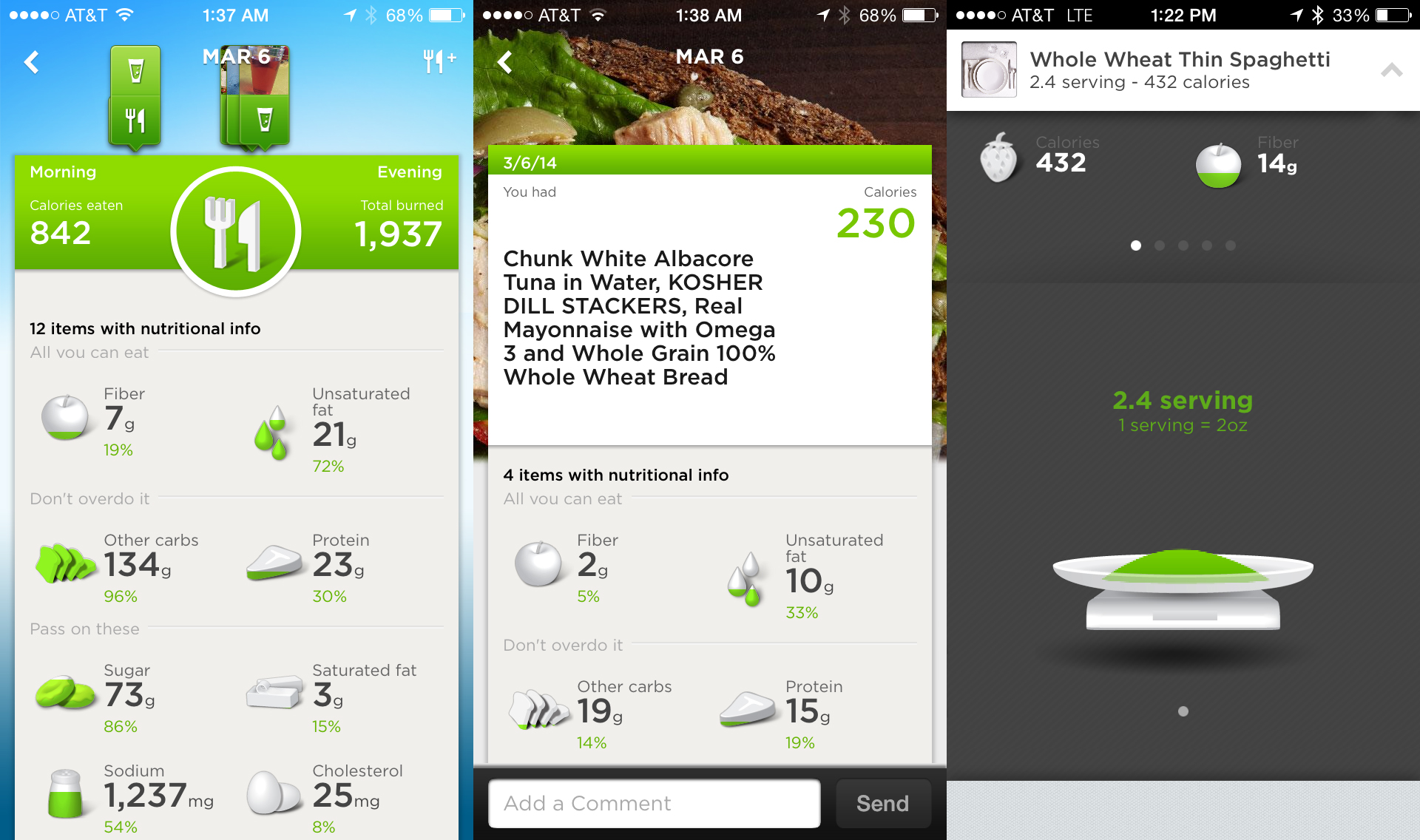
Meal tracking
No one gets food logging quite right, but the Jawbone Up24 app comes close. That's because it uses a barcode scanning in conjunction with an iOS or Android camera and a food product's UPC code. There's also the traditional nutritional database available.
While this kind of tracking functionality is nothing new, for Aussies there has traditionally been a tendency for local food products to be overlooked on the database for scanning foods.
Ultimately we had about a 60 per cent success rate when scanning food. Big name brands like Snickers and Twinings tea all scanned fine - as did most Aldi produce - but a Cadbury's block of chocolate came back negative.
You can manually add the nutritional information if it doesn't appear in the database. The problem is that it doesn't add it to the database, meaning the next time you scan the barcode you'll hit the exact same roadblock.
Meals are tracked on the main screen with a green bar that sits next to the orange activity and purple sleep measurements. It's given as much prominence as activity and sleep, but maintaining its presence by scanning or typing in a food and then figuring out how much has been consumed is tedious.
Waiter, may I see this dish's bar code? Matters are made worse when eating out. The convenient barcode option isn't viable at restaurants and the food database only goes so far. How are you supposed to log Chicken Tikka Marsala at your local Indian restaurant without bringing in a scale? This place doesn't even allow outside drinks.
The Fitbit app, without a barcode scanner, is even more useless for meal planning and the Nike FuelBand app doesn't bother to track food.
You can try using a third party app like MyFitnessPal to track your food consumption and integrate it via the Up's API, but many of the issues around eating out and an incomplete database remain.
So generally, you'll probably find that the food-tracking aspect of the device will go unused pretty quickly after you start wearing the Up24 band.
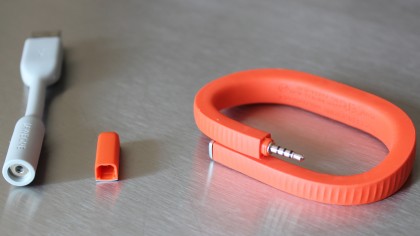
Battery life
Bluetooth syncing has reduced the Jawbone Up24 battery life to a still-impressive seven days, down from the ten that the original had promised. That's a fair exchange for the added wireless syncing functionality between the bracelet and app.
No one wants to go back to manually twisting off the cap then plugging the Jawbone into an iOS or Android device just to see how many steps they have walked. Instead, Bluetooth 4.0 keeps the bracelet on your wrist while maintaining a respectable battery cycle. It's not quite as long as the seven to ten days that the Fitbit Force and Nike FuelBand SE lasted in our tests.
To make up for that, a real-time battery drain calculator is provided in the Jawbone Up24 app. It reads that there are "7 days left" right after a charge and, a week later, predicts "about a day" right before the bracelet needs to be plugged back in. That's much better than a vague, slowly draining battery icon.
Not as straightforward is the fact that the Jawbone Up24 uses a 2.5mm stereo inline jack to charge. That's the smaller headphone jack size that everyone hated about the original iPhone. While a 2.5mm-to-USB adapter is included so that the bracelet can be plugged into any USB port, the connector a measly four inches and very easy to lose.
The original Jawbone Up used the standard 3.5mm, so that size should have been maintained or the company should've switched over to a micro USB plug instead.
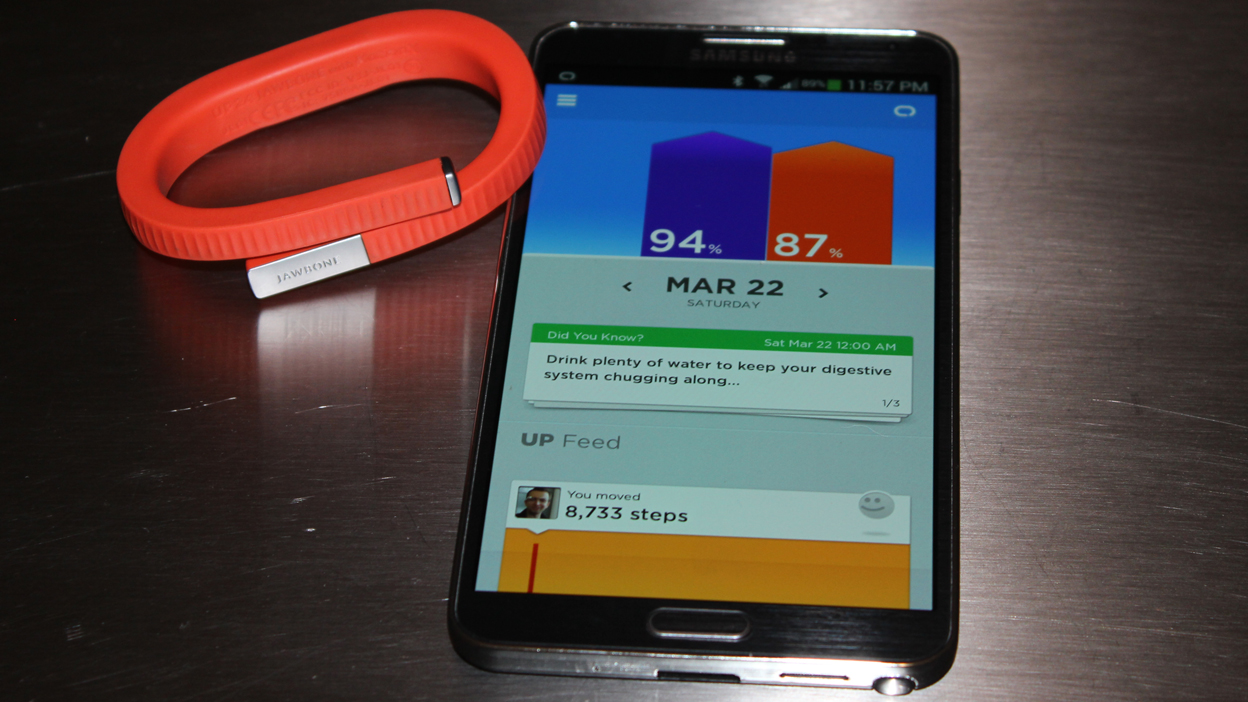
Compatibility
Jawbone Up24 is expanding its app compatibility list now that it supports a handful of Android phones in addition to iOS devices containing the key ingredient: low-energy Bluetooth 4.0.
As long as Apple fans are on the iPhone 4S or newer or the iPad 3 or newer, wireless syncing will work between the bracelet and the app. Much to the chagrin of Android owners, this was the exclusive way to sync the two until mid-March.
Requirements are a bit more stringent for Google-powered smartphones. Up24 requires Bluetooth 4.0, Android 4.3, and currently won't work with any Android tablets.
The Android list is rather small with Samsung leading the pack for most supported devices: the Galaxy Note 3, Galaxy Note 2, Galaxy S4, and Galaxy S3. The LG Nexus 4 and Nexus 5, Moto X and Moto G, Sony Xperia Z1 and HTC One also made the list.
This pales in comparison to the 44 iOS and Android devices that are Fitbit-compatible, including the newly announced HTC One M8 that features an integrated Fitbit menu. But Jawbone Up24 is further along than it was just a few days ago.
The Android support issue is compounded by the question marks over when handsets get updates. We started testing the device after checking the Android compatability list and seeing the Xperia Z1, but when it came time to pair with Sony's handset, we were hamstrung by the fact that the phone was only running Android 2.2.
Fortunately, the phone got updated to 4.4 the next week, but there are significant question marks over Android support that should be researched before purchase.
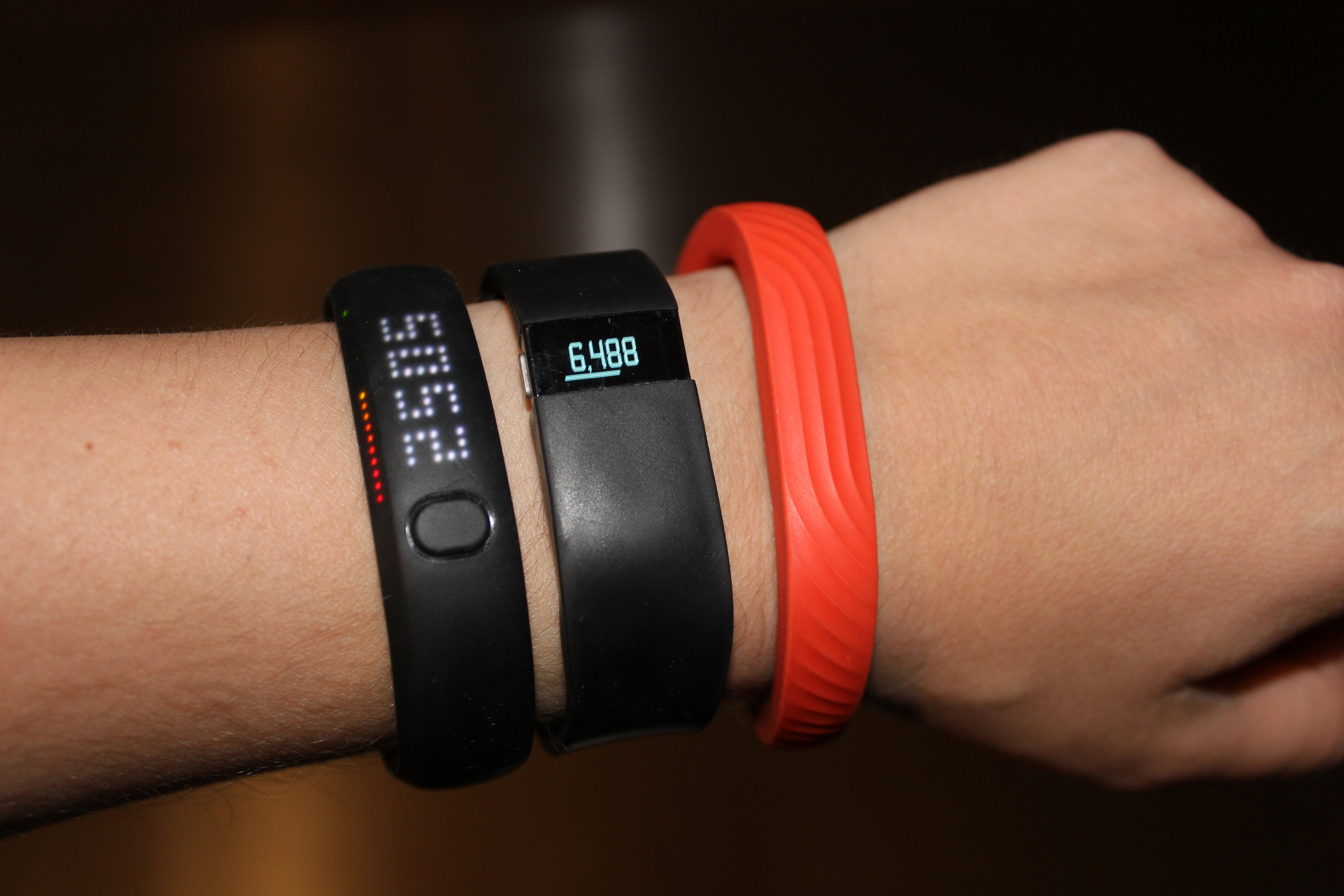
Price
Bluetooth syncing comes at a price. The Jawbone Up24 costs $180 compared to the cheaper original at $150 and it's now available in 29 countries including Australia, the UK and most of Europe.
Even with the added expense, it's hard to put a price on not having to physically attach the older version to a phone's stereo jack for each and every update. Wirelessly syncing activity data is a convenience that could help you avoid dropping the habit of wearing the bracelet. Our brains often look for any barrier to entry when working out, so it may be worth the extra cash in the end.
The price is also fairly consistent with the Nike FuelBand SE about AU$190, and although the Fitbit Force was cheaper at $169, it was recalled and never made its way out of the US and Canada.
As it's solely a fitness tracker, Jawbone Up24 is also cheaper than health-and-smartwatch combos like the Samsung Gear Fit that's $249, and it's likely to be cheaper then multifaceted Android Wear watches and Apple's rumoured iWatch.
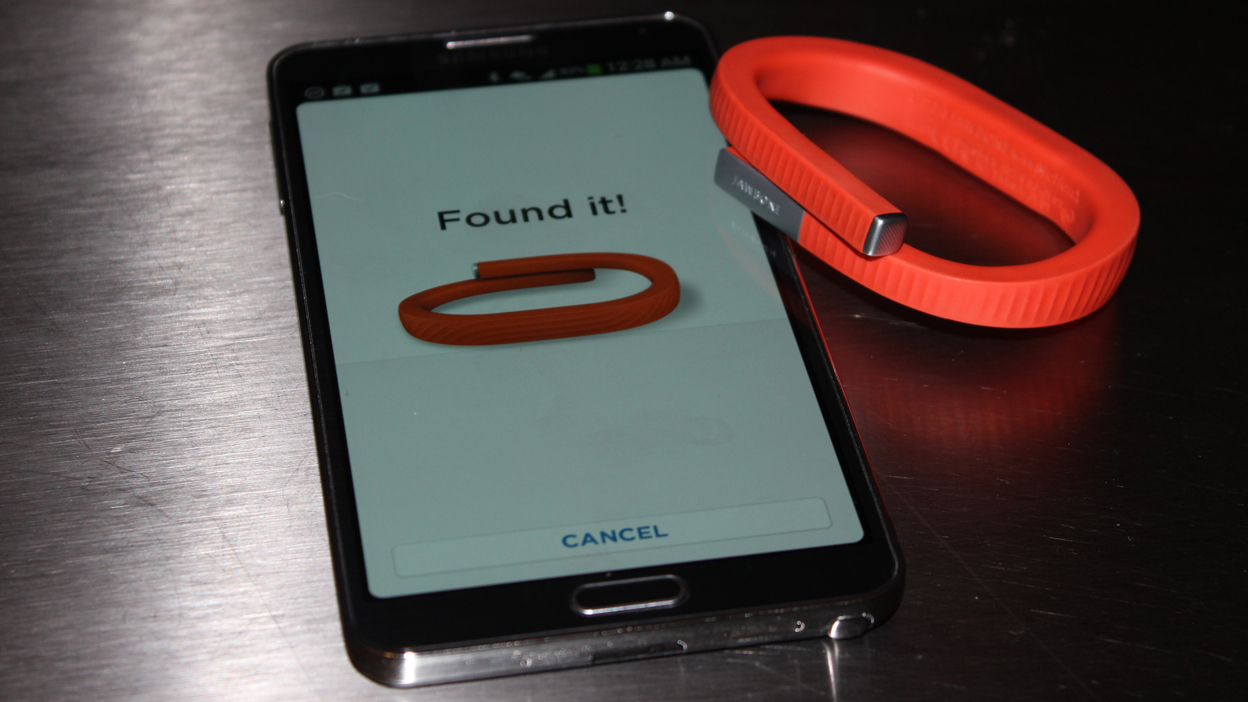
We liked
Jawbone Up24 stands out from rival fitness and sleep tracking wearables thanks to its textured, yet ultra-soft bracelet design. That's to be expected. Jawbone is known for making Bluetooth headsets more fashion forward than backward, and it's done the same for its fitness trackers.
It goes the extra mile this time by wirelessly syncing steps and sleep data to its robust app via Bluetooth. That's something the original Jawbone Up bracelet didn't include despite the fact that the company is primarily known for the technology.
With an inviting, colourful app, it's exciting to check everyday and easy to comprehend the all-important activity and sleep stats. Extras like idle alerts and "Today I Will" challenges go a long way to improve those scores.
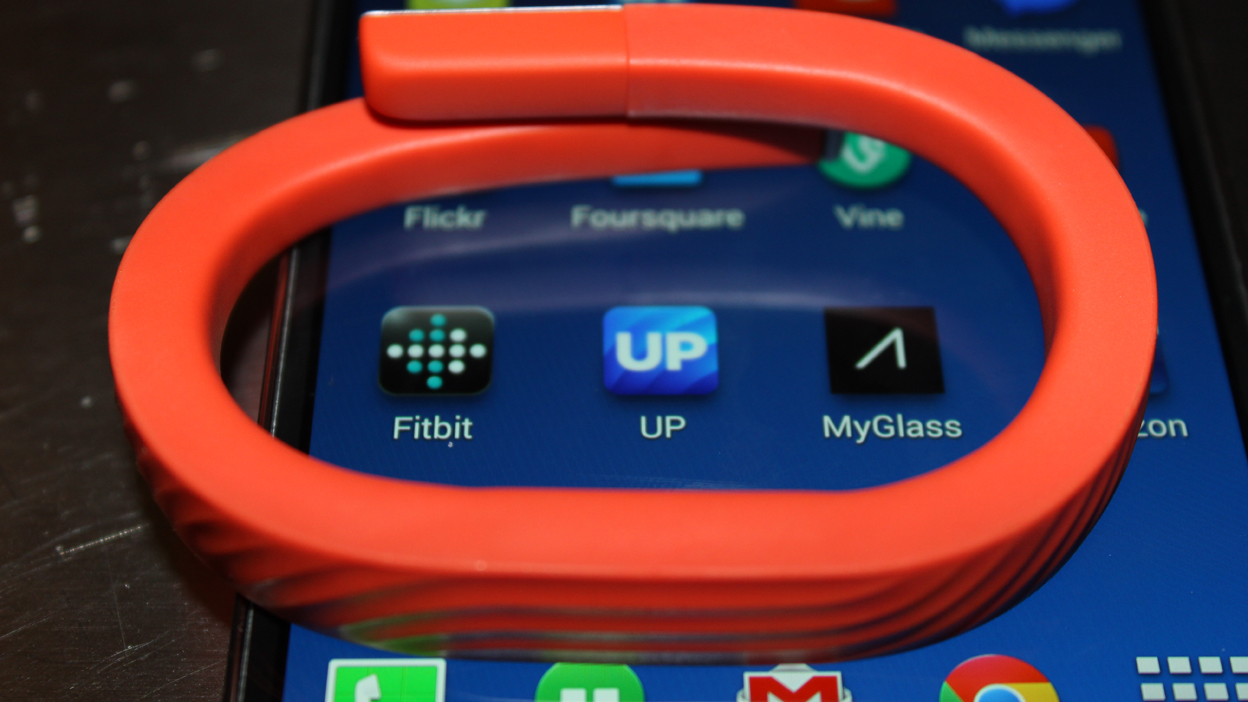
We disliked
As vivid as the app is on a smartphone, the same stats can't be quickly checked on the device itself because it lacks a native display. That severely limits its usefulness among runners who want on-demand metrics. There's also no web-based portal to get a better grasp of your overall performance. The 9.7-inch iPad Air screen is the biggest Jawbone Up24 display in town.
It's seven-day battery life isn't terrible, even though it drains faster than the Nike FuelBand SE and Fitbit Force. The real problem is the it requires a 2.5mm jack to be charged. It comes with a 2.5mm-to-USB charger that's way too easy to lose.
Even if these cons are acceptable, a few people won't be able to bypass the fact that this wireless Jawbone Up can't sync with nearly as many Android devices as the Fitbit Force, and all Android tablets are incompatible at this point. While Samsung's current flagship phones work with the Bluetooth-enabled bracelet, the new Galaxy S5 isn't on the list yet, and the same applies to the HTC One M8.
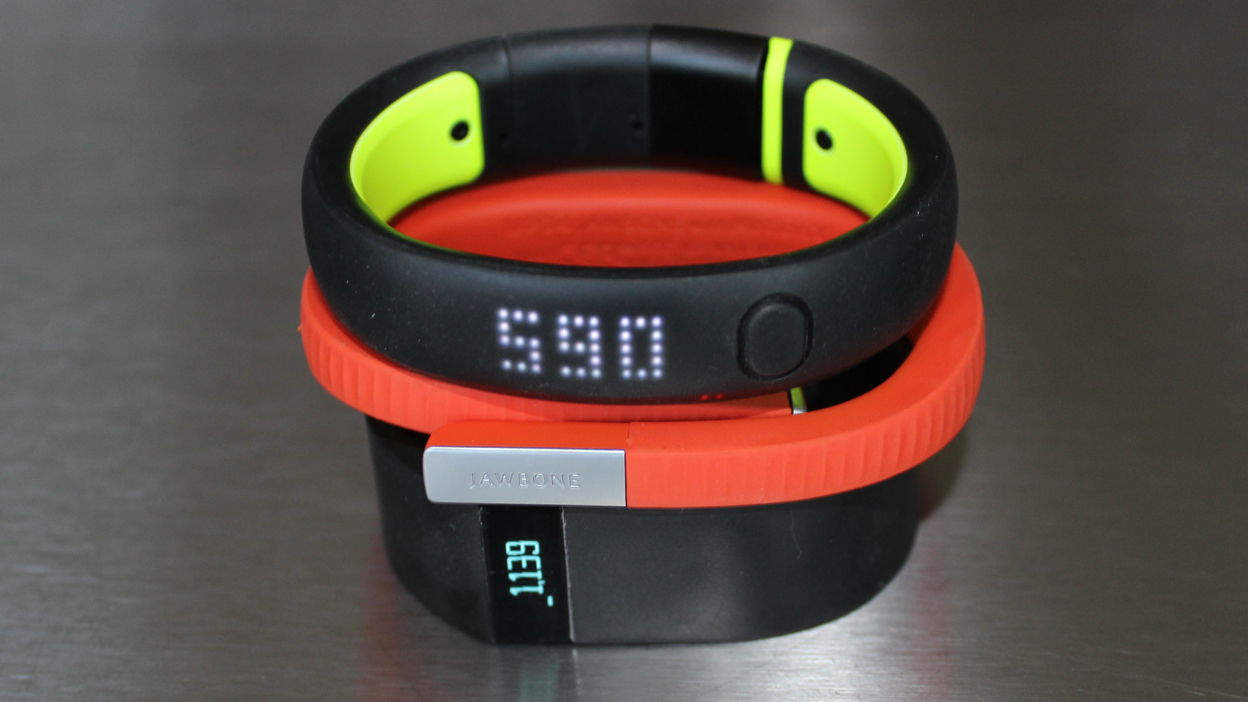
Final Verdict
The Jawbone Up24 is one of the most inspiring fitness wearables that you can latch onto your wrist. It's fashionable, lightweight design makes it easier to wear for a full 24 hours compared to its plain-looking, anchor-like competition. This doesn't feel like you're wearing a single handcuff. Better yet, the accurate activity and sleep tracking metrics make it useful both day and night.
It's even more motivating when syncing all of this data to the bright-and-cheery Jawbone Up 3.0 app. Charting out steps and sleep quality explains where you're making progress and where you're letting yourself down. Your life is analysed every swipe down to refresh.
The Fitbit Force recall makes the Jawbone Up24 the ideal choice among fitness tracking wearables by default. Even if that weren't the case, this bracelet would have a slight edge given its more comfortable design, easier-to-read app and better accuracy, all of which drive a more informed if not healthier lifestyle.
